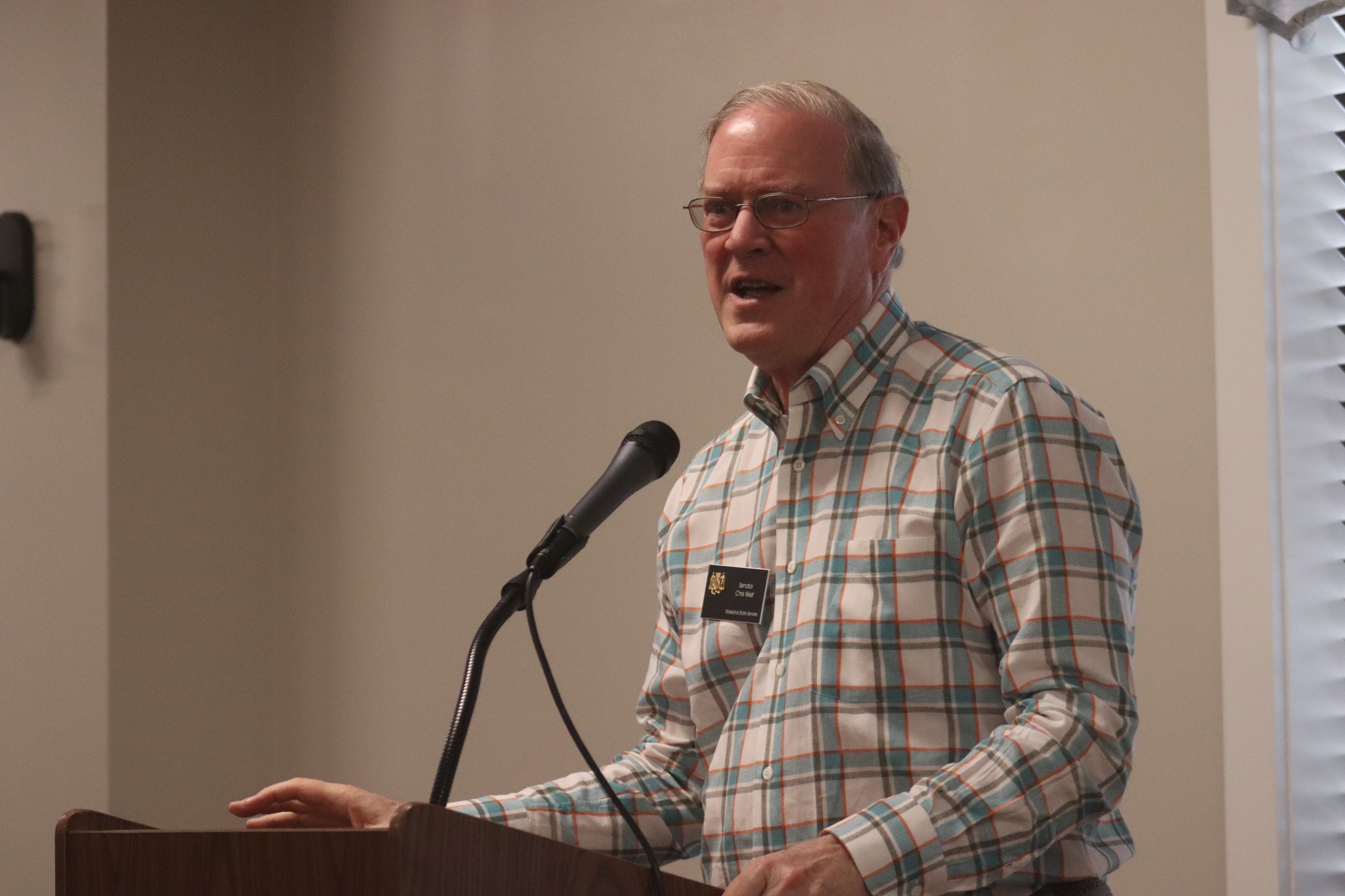
The following message was sent out by Maryland State Senator Chris West (District 42) on January 2nd:
Chickens Coming Home to Roost
A Happy New Year to all!
This is the first of several messages that I plan to send out previewing the 2024 General Assembly Session. A lot is going to happen during the 90 days between January 10 (Opening Day) and April 8 (“Sine Die”), but I think that much of what we are going to face could be described by the old phrase “chickens coming home to roost”. Or, to use another expression, “unanticipated collateral consequences”.
My views were crystallized by a recent report of a discussion this past summer about Covid by Dr. Francis Collins, whom you may recall was the head of the National Institute of Health during the height of the pandemic. During that period, Dr. Collins and Dr. Fauci were omnipresent on television delivering nightly pronouncements about what we all needed to do, insisting that their recommendations were based upon established medical science. Our national and local political leaders, including Maryland Governor Larry Hogan, took their recommendations as gospel and issued proclamations reordering our lives accordingly.
In Dr. Collins’s recent comments, he said, “If you’re a public-health person and you’re trying to make a decision, you have this very narrow view of what the right decision is, and that is something that will save a life. So you attach infinite value to stopping the disease and saving a life. You attach a zero value to whether this actually totally disrupts people’s lives, ruins the economy and has many kids kept out of school in a way that they never quite recovered.” Dr. Collins thus accepted the fact that, with 20-20 hindsight, he and Dr. Fauci had worn myopic blinders and had ignored the unanticipated collateral consequences of the policies they imposed upon the country.
Other highly credentialed experts, both doctors and scientists, put forward an alternative analysis, promoting a strategy of “focused protection” of the elderly and vulnerable, while letting most of us continue with our ordinary lives even as we took reasonable precautions. Drs. Collins and Fauci led a successful effort to discredit the alternative approach, and we all suffered the consequences. To put it bluntly, the chickens came home to roost. The national economy virtually shut down for a period of time, and then to get things moving again, the federal government spent trillions of dollars, triggering massive inflation. At the same time, schools were shut down for the spring and fall semesters of 2020 as well as the spring semester of 2021. Many young people were permanently damaged in the process.
Certainly, Drs. Collins and Fauci strongly believed that their course was the best course. They acted with the best of intentions but with unrelenting hubris. Governor Hogan, who carefully implemented their recommendations here in Maryland, also confidently believed that in shutting down the State of Maryland and its schools, he was taking the only responsible course. No one particularly focused on the unanticipated collateral consequences of their policies. It is now pretty clear that the alternative strategy of “focused protection” was the better approach and that enormous damage was done to the nation and its citizens by the policies promulgated by the so-called experts. We have all suffered as a result.
Unfortunately, the problem of elite experts imposing their policies on citizens powerless to object has occurred repeatedly here in Maryland in recent years. The progressive movement is ardently supported by all of the State’s media, including the Baltimore Sun, the Baltimore Banner, the Washington Post, Maryland Matters and MPT, so counter-arguments are rarely given a voice, either in the news articles, in editorials, on the op ed pages or in letters to the editor. Progressive activist groups financed by wealthy donors and foundations swarm to Annapolis to fill the hearing rooms, dominating legislative debates. In Annapolis, progressives win nearly every battle as compliant legislators, fearing being “primaried” in the next election, routinely enact legislation promoted by these activists and endorsed by the media. But in the long run, while the General Assembly can enact bills, it cannot repeal the laws of economics, and while the potential collateral consequences of new legislation can be ignored by legislators determined to curry favor with activist groups, ultimately those consequences will inconveniently crop up and will have to be handled. This year, will be the year that many of those chickens come home to roost.
Let’s start with the so-called “Blueprint”, also known as the Kirwan plan. This piece of legislation, the brainchild of the State teachers’ unions, calls for spending $32 Billion in additional money over a ten-year period in ways intended to transform Maryland’s public schools and make them not just the best schools in the United States but indeed the best schools in the entire world. Better than schools in Sweden, the Netherlands and other nations with stellar systems of public education. This was the promise sold to the General Assembly in 2020, and most legislators bought it hook, line and sinker. The Blueprint had serious problems that should have been obvious at the outset, but the General Assembly was unwilling to push back against the teachers’ unions and so passed the bill overwhelmingly.
I voted against the Blueprint for three reasons. First, the cost was astronomical, and no way to pay for the program had been identified. Second, I could not figure out how the several components of the program would transform Maryland public education, as promised. Third, the Blueprint set forth a “one size fits all” ten-year program that left the State’s counties with little flexibility in their implementation of the Blueprint and the threat of a cutoff of State aid to education if they didn’t fully comply with the program.
We are now approaching the fourth anniversary of the vote in 2020 to move forward with the Blueprint. So how are things working out – as promised, or are those chickens coming home to roost? I’ll deal with the unfunded costs in a subsequent message, but the “one size fits all” aspect of the program is turning out to be a serious Achilles heal. Each county seems to be encountering different logistical problems complying with the law. One element of the Blueprint is that it forces each county to implement pre-kindergarten education for all four year olds. But the counties don’t have the physical facilities to accommodate all of those children; there are not enough qualified teachers to staff the classrooms; there are not enough private providers of pre-kindergarten education to supply the need; and the county bus systems are not equipped to safely transport four year olds to school and back home. It now appears that no county school system in the State will be able to achieve the target goals required by the Blueprint by the statutory deadlines.
There are other serious “one size fits all” problems with the Blueprint. In some counties which currently have great public education systems, the Blueprint requires them to divert huge amounts of money each year to special programs that are not necessary, resulting in the need to economize in other areas, such as by greatly increasing class sizes, thus making it impossible for teachers to effectively teach.
The Blueprint is riddled with arbitrary deadlines, and in most cases, if a county does not achieve the required results by the deadline, it faces the loss of its state education funding, which in turn would cripple the county public school system.
Turning to my second problem with the Blueprint, whether it would indeed make Maryland’s system of public education the best in the world in just ten years, it bears noting that although the Blueprint has now been the law of Maryland for nearly four years, the most recent annual “Report Card” issued showing the quality of public school education in Maryland shows that academic achievement in Maryland has been declining, not rising. The year before the Blueprint was enacted into law, the Report Card showed 189 five star schools in Maryland and 585 four star schools. Today, the Report Card shows only 85 five star schools and only 409 four star schools. The promise that the Blueprint would transform Maryland schools into the best schools in the entire world increasingly appears to have been a false promise. In short, it is becoming more and more evident that the General Assembly was stampeded by the teachers’ unions into enacting the Blueprint. But the fact remains that the Blueprint is currently the law of Maryland. It still has six more years to go, and the massive bill for this effort has hardly begun to come due.
Certainly, in light of the developing awareness that the General Assembly bit off more than the State could chew with the Blueprint, efforts will be made during the upcoming Session to make some needed changes to the Blueprint. One change that might alleviate some of the angst would be to extend the timeline for the Blueprint from ten years to twelve or fifteen years. But with the teachers’ unions resistant to any changes in their hard-won victory in 2020, it remains to be seen whether good sense will prevail this year or alternatively whether the General Assembly will double-down on what is increasingly being seen as an embarrassing fiasco.
My next pre-Session message will focus on the State’s draconian environmental deadlines which allegedly are needed to combat world climate change, on the State’s parlous budgetary problems, on the proposed drastic cuts to the State’s transportation program and on the likelihood that significantly higher taxes will be enacted by the General Assembly in the 2024 Session. In short, there are lots more chickens in line, all set to come home to roost in the 2024 Session of the General Assembly.
Stay tuned.
-Chris
###
Follow the Carroll County Observer on all of our social media channels to keep up to date with the latest information for our community.
- https://facebook.com/CarrollObserver
- https://tiktok.com/@carrollobserver
- https://twitter.com/CarrollObserver
- https://instagram.com/carrollobserver/
- https://youtube.com/@carrollobserver
- https://truthsocial.com/@carrollobserver
- https://rumble.com/c/c-4218154






[…] The following message was sent out by Maryland State Senator Chris West (District 42) on January 8th: (note – you can view Part 1 HERE) […]